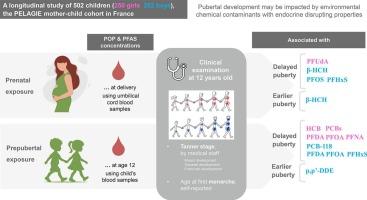产前和青春期前接触有机氯化合物和全氟烷基物质与12岁时的青春期发育:PELAGIE队列研究
IF 9.7
1区 环境科学与生态学
Q1 ENVIRONMENTAL SCIENCES
引用次数: 0
摘要
背景:越来越多的证据表明,产前和青春期前接触有机氯化合物(OCs)和全氟烷基物质(PFASs)与儿童的生殖健康有关。本研究考察了这些暴露对12岁儿童青春期发育的潜在影响。方法基于法国PELAGIE母婴队列,测量脐带血(2003年至2006年)和12岁(2016年至2018年)血液中OCs和PFASs的浓度。医务人员在12岁时评估青春期发育(坦纳阶段),女孩每年自我报告初潮年龄(9-16岁)。使用多项逻辑回归模型和Cox回归模型分析暴露与青春期发育延迟或提前之间的关系,调整混杂因素,并对化合物混合物使用分位数g计算。结果在502名儿童中(250名女孩,252名男孩,中位年龄:12.8 岁),女孩产前PFUdA暴露与乳房发育迟缓有关[OR(95 %CI): 2.05(1.03,4.06)]。在男孩中,产前PFHxS暴露与性腺早期发育风险降低相关[0.47 (0.26,0.83)],β-HCH与阴毛发育延迟[0.66(0.43,0.99)]和早期[0.69(0.48,0.97)]风险降低相关。女孩在青春期前暴露于HCB、PCBs和PFASs与乳房发育延迟的风险增加相关[例如,PFOA: 2.53(1.04,6.12)]和月经初潮年龄的推迟[例如,ΣPCBs: HR 0.77(0.61,0.97)]。在男孩中,青春期前p,p ' -DDE与青春期提前的风险增加有关[性腺发育:1.77 (1.09,2.88);阴毛生长:1.56(1.01,2.44)],而PCB-118与发育迟缓有关。青春期前PFASs与青春期提前的风险降低相关[例如,pfhxs -性腺阶段:0.39(0.20,0.75)]。在混合分析中,没有观察到产前暴露的关联,但青春期前暴露与女孩青春期发育延迟有关。结论产前和青春期前暴露于OCs和PFASs可能会影响12岁女童和男童的青春期发育,值得进一步研究。本文章由计算机程序翻译,如有差异,请以英文原文为准。

Prenatal and prepubertal exposures to organochlorine compounds and perfluoroalkyl substances and pubertal development at age 12: The PELAGIE cohort study
Background
Emerging evidence suggests that prenatal and prepubertal exposure to organochlorine compounds (OCs) and perfluoroalkyl substances (PFASs) is associated with children’s reproductive health. This study examines the potential impact of these exposures on pubertal development in 12-year-old children.Methods
Based on the French PELAGIE mother–child cohort, concentrations of OCs and PFASs were measured in cord blood (from 2003 to 2006) and in blood at age 12 (from 2016 to 2018). Medical staff assessed pubertal development (Tanner stages) at age 12, and girls self-reported age at menarche annually (ages 9–16). Associations between exposures and delayed or earlier pubertal development were analyzed using multinomial logistic and Cox regression models, adjusting for confounders, and using quantile g-computation for compound mixtures.Results
Among 502 children (250 girls, 252 boys; median age: 12.8 years), prenatal PFUdA exposure in girls was associated with delayed breast development [OR (95 %CI): 2.05 (1.03,4.06)]. In boys, prenatal PFHxS exposure was associated with reduced risk of earlier gonadal development [0.47 (0.26,0.83)], and β-HCH with reduced risks of both delayed [0.66 (0.43,0.99)] and earlier [0.69 (0.48,0.97)] pubic hair development.Prepubertal exposure in girls to HCB, PCBs, and PFASs was associated with increased risk of delayed breast development [e.g., PFOA: 2.53 (1.04,6.12)] and later age at menarche [e.g., ΣPCBs: HR 0.77 (0.61,0.97)]. In boys, prepubertal p,p’-DDE was associated with increased risk of earlier puberty [gonadal development: 1.77 (1.09,2.88); pubic hair growth: 1.56 (1.01,2.44)], while PCB-118 was associated with delayed development. Prepubertal PFASs were associated with reduced risk of earlier puberty [e.g., PFHxS-gonadal stages: 0.39 (0.20,0.75)].In mixture analyses, no associations were observed with regards to prenatal exposure, but prepubertal exposure was associated with delayed pubertal development in girls.Conclusion
Prenatal and prepubertal exposure to OCs and PFASs may alter pubertal development at age 12 in girls and boys, underscoring the need for further research.求助全文
通过发布文献求助,成功后即可免费获取论文全文。
去求助
来源期刊

Environment International
环境科学-环境科学
CiteScore
21.90
自引率
3.40%
发文量
734
审稿时长
2.8 months
期刊介绍:
Environmental Health publishes manuscripts focusing on critical aspects of environmental and occupational medicine, including studies in toxicology and epidemiology, to illuminate the human health implications of exposure to environmental hazards. The journal adopts an open-access model and practices open peer review.
It caters to scientists and practitioners across all environmental science domains, directly or indirectly impacting human health and well-being. With a commitment to enhancing the prevention of environmentally-related health risks, Environmental Health serves as a public health journal for the community and scientists engaged in matters of public health significance concerning the environment.
 求助内容:
求助内容: 应助结果提醒方式:
应助结果提醒方式:


